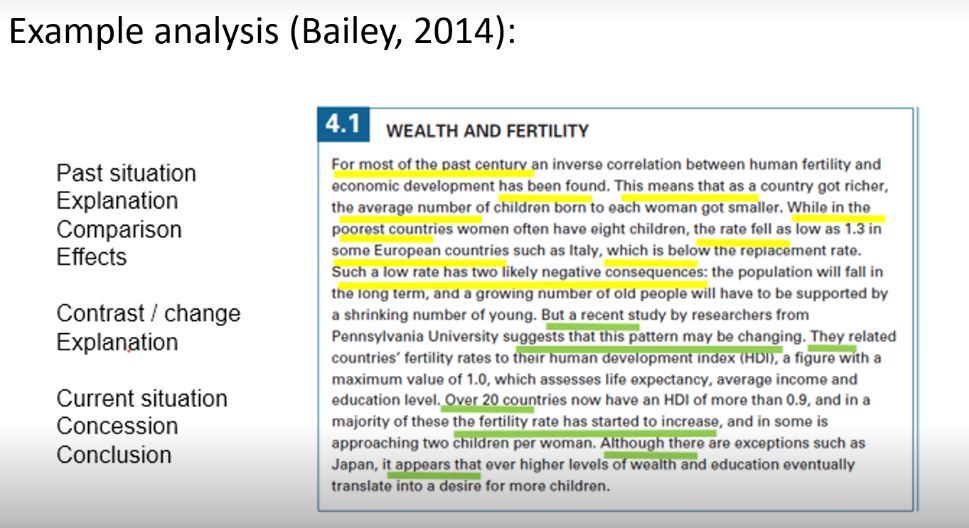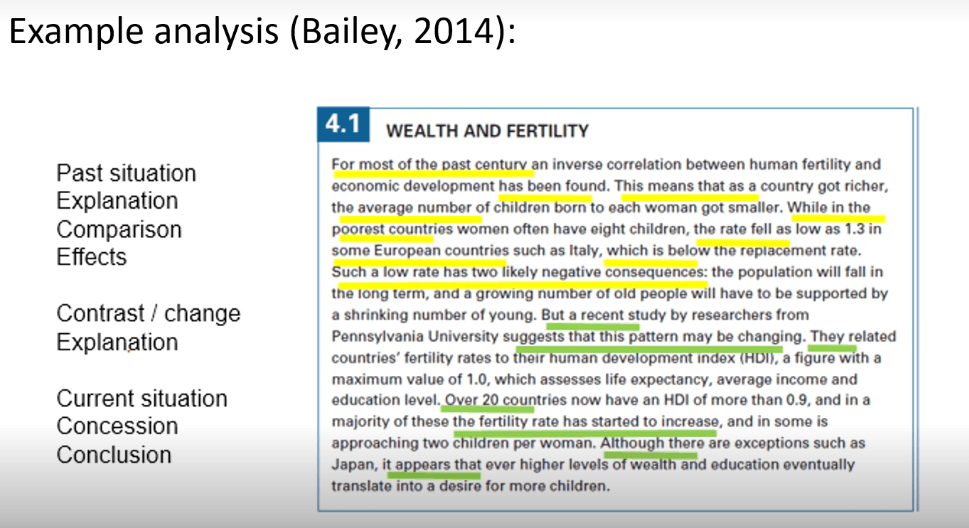How to summarize?
What makes a good summary of a text?
1. Summaries must be shorter than the original text.You will
often summarise whole paragraphs, texts, or ideas in a muchshorter way. (Shorter)
2. Summaries must be written in your own words, and include
a reference to the original text.(Use own words)
3. Summaries must contain the key ideas of the text clearly and
concisely. (Main ideas)
How do we summarise effectively? A number of steps canhelp us:
1. Skim read the text & ensure you have understand the
main purpose
2. Highlight key information. lgnore less important
information
3. Take notes of your highlighted points
4. Write your concise summary from your notes, using your
own words


To summarise the 'Wealth and Fertility' text(Bailey, 2014)in one sentence, we could write:
Research suggests that the long-term decline in humanfertility may be reversing in some of the most developedsocieties (Bailey, 2014).
Here are the steps of summarizing.
his begins with skimming the text to get an overall idea. After this, you should read more carefully and highlight the main points and supporting points (but ignore supporting examples and details). After this you will take notes, in your own words. You are then ready to write the summary itself. When this is done your task is not, as you should check the summary to make sure you have included all the main points and have a reference to the source.
The following flowchart outlines the steps in writing a summary.
|
Skim
Skim the text, paying special attention to any headings or subheadings. |
|
Highlight
Read the text again more carefully, underlining/ highlighting important information. Check any unknown words needed to understand the main points. |
|
Note-taking
Make notes of the main points and supporting points (not supporting examples or details). Remember to use your own words so that you can paraphrase and avoid plagiarism. |
|
Writing
Write the summary using your notes. Make sure you do not add anything which does not appear in the original (e.g. your own comments). |
|
Checking
Check the summary to make sure you have covered all the main points. Make sure you have included a reference to the source. |
Language for summary writing
Although most of the language in the summary will depend on the content, there are some formulaic phrases which can be used in a summary to help to make it clearer. These can be divided into three types: the frame, which begins the summary; reminder phrases, which are used throughout the summary; and transition signals, which are used in certain parts of the summary.
The frame
The frame is the main idea of the article. This is usually included in the first sentence, with a reference to the author and the main idea or argument of the text. You will also need to use a reporting verb. Some examples of frames are shown below, for an article titled "The Global Warming Crisis" by F. Brown, published in 2014. These use the Harvard style of referencing, but can be adapted to other styles.
- According to Brown (2014), ...
- Brown's (2014) article on global warming discusses...
- Brown (2014), in his article "The Global Warming Crisis", argues that...
Reminder phrases
It is useful to remind the reader, especially in a longer summary, that you are summarising another text. This is done by using reminder phrases such as the ones shown below. Using these also helps to avoid plagiarism, as these phrases include a reference to the source, thus making clear that the ideas are not your own (a mistake many beginning academic writers make is to just include a reference at the beginning, but if the summary is long, this is not enough).
- The author goes on to say that...
- The article further states that...
- The author further states that...
- (Author's last name) also states/ maintains/ argues/ believes that...
- (Author's last name) concludes that...
Note: In the last two examples, it is enough to include the author's name without the year (if using the Harvard or APA style of referencing, which require a year) as you have already given the year earlier in the summary, in the frame, and you do not need to repeat the year throughout the summary.
Transition signals
Pay attention to the organisation of the original text, and use appropriate transition signals when organising the ideas in your summary. For example, you may need comparison and contrast signals, cause and effect signals, classification signals, and so on.
Checklist
Below is a checklist for summarising. Use it to check your own summary, or get a peer (another student) to help you.
| Area | Details | OK? | Notes/comment |
| Summarising skills | All the main ideas and supporting points from the text have been included in the summary. | ||
| Supporting examples and details have not been included. | |||
| The text has been paraphrased enough to avoid plagiarism (no copied chunks). | |||
| Summary language | The summary includes a frame which states the main idea or argument of the summary. | ||
| If the summary is long, it includes reminder phrases. | |||
| Referencing skills | The paraphrase includes an in-text citation for the source text. | ||
| Meaning | The meaning of the text is the same as the original. The writer has not added their own opinion or comments in the summary. | ||
| Length | The length of the text is much shorter than the original. |



【推荐】编程新体验,更懂你的AI,立即体验豆包MarsCode编程助手
【推荐】凌霞软件回馈社区,博客园 & 1Panel & Halo 联合会员上线
【推荐】抖音旗下AI助手豆包,你的智能百科全书,全免费不限次数
【推荐】博客园社区专享云产品让利特惠,阿里云新客6.5折上折
【推荐】轻量又高性能的 SSH 工具 IShell:AI 加持,快人一步